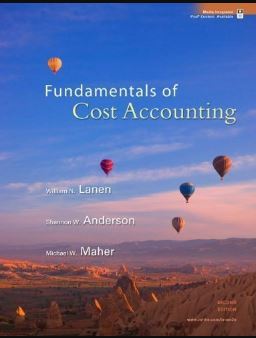
Fundamentals of Cost Accounting 2nd Edition by William Lanen, Carolyn Wells, Michael Maher
Edition 2ISBN: 978-0077274993
Fundamentals of Cost Accounting 2nd Edition by William Lanen, Carolyn Wells, Michael Maher
Edition 2ISBN: 978-0077274993 Exercise 18
Balanced Scorecards and Strategy Maps
Following several years of tight budgets, administrators at the University of California, Davis, looked for ways "to do more with less." Janet Hamilton, vice chancellor of administration, researched books and articles, met with consultants, and talked to her counterparts at universities across the United States to find new management methods that could change the university from a bureaucratic to a customer-oriented organization. She learned about reengineering, total quality, and a variety of other management techniques. None of the management techniques appealed to her, until she came across articles about the balanced scorecard. She believed that the balanced scorecard was the right tool for the Davis campus, and she set about implementing it.
At first, Hamilton did not call her approach a "balanced scorecard," because she feared that employees would think of this as just another management fad to endure until the administration went on to something new. Instead, she pilot-tested the balanced scorecard ideas in one service department, environmental health and safety (EHS), until it worked. With the success of EHS behind her, she moved to implement the balanced scorecard in other service departments, such as police, fire, and printing services.
Each department developed its own particular performance measures to achieve the following objectives (we have shortened the list to save space):

Required
a. Was the vice chancellor overly cautious in not calling her approach a "balanced scorecard"
b. Comment on the wisdom of beginning a balanced scorecard with a pilot project. Would it be possible to extrapolate the experience of a service department, such as environmental health and safety, to an academic unit, such as a college of business
c. What opportunities and difficulties do you see in applying a balanced scorecard to a university setting
Source: Adapted from interviews with university administrative staff.
Following several years of tight budgets, administrators at the University of California, Davis, looked for ways "to do more with less." Janet Hamilton, vice chancellor of administration, researched books and articles, met with consultants, and talked to her counterparts at universities across the United States to find new management methods that could change the university from a bureaucratic to a customer-oriented organization. She learned about reengineering, total quality, and a variety of other management techniques. None of the management techniques appealed to her, until she came across articles about the balanced scorecard. She believed that the balanced scorecard was the right tool for the Davis campus, and she set about implementing it.
At first, Hamilton did not call her approach a "balanced scorecard," because she feared that employees would think of this as just another management fad to endure until the administration went on to something new. Instead, she pilot-tested the balanced scorecard ideas in one service department, environmental health and safety (EHS), until it worked. With the success of EHS behind her, she moved to implement the balanced scorecard in other service departments, such as police, fire, and printing services.
Each department developed its own particular performance measures to achieve the following objectives (we have shortened the list to save space):

Required
a. Was the vice chancellor overly cautious in not calling her approach a "balanced scorecard"
b. Comment on the wisdom of beginning a balanced scorecard with a pilot project. Would it be possible to extrapolate the experience of a service department, such as environmental health and safety, to an academic unit, such as a college of business
c. What opportunities and difficulties do you see in applying a balanced scorecard to a university setting
Source: Adapted from interviews with university administrative staff.
Explanation
a. Some organizations are concerned that...
Fundamentals of Cost Accounting 2nd Edition by William Lanen, Carolyn Wells, Michael Maher
Why don’t you like this exercise?
Other Minimum 8 character and maximum 255 character
Character 255


